Horst Müller - Alwinson
Jim Harris - Ernieson
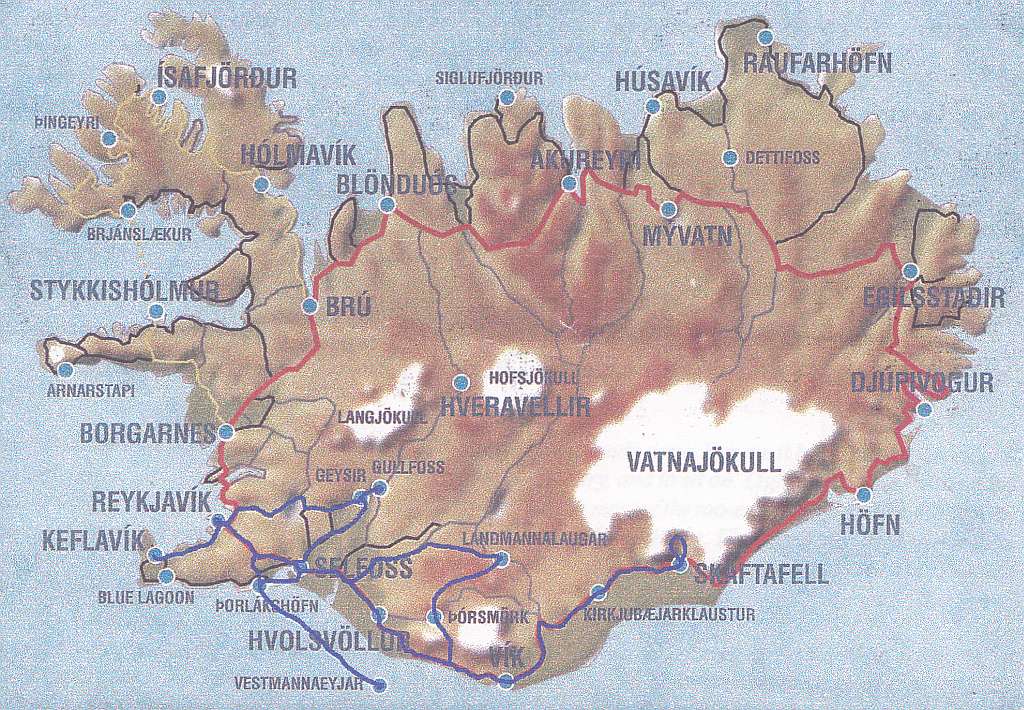
ICELAND 2000
A report on a visit to Iceland by the two intrepid explorers:
Horst Müller - Alwinson
Jim Harris - Ernieson

The report of our first trip to Iceland, us was Jim and I. That was in 2000, it took us mainly through the south up to Skaftafell, the major hike being from Skogar to Landmannalaugar. Following the sequence of events.
How did the idea of going to Iceland develop? You may remember that when we went to Greenland two years ago the plan had been to do the lot, that is Iceland and Greenland. But we found the expenses (air tickets) a bit too much. Coming back from Greenland we landed in Kevlavik for refuelling and on the way out got a glimpse of the area to the south of Skaftafell, the huge flood plain. It looked wild and it was then decided that we must do this one day. So the day came and we went off to Heathrow and from there to Keflavik.
Planning for the trip had became something of a routine. I got most of the info from the Internet and the maps of the various areas from the printer in Iceland. Two very good books on the subject I found in a book store in Basel, one gave all the touristy information and the second one was about specific hiking routes.
Packing was relatively easy, one spare set of underpants, socks, long pants and shirt. That was what I took on clothing apart from what I was wearing. The long pants I took along could double up as longs and shorts; Eleni had very cleverly provided a zip on the legs. And not to forget, I also took a pair of swimming trunks, yes, that was for the numerous hot pools one would find in Iceland.
Money-wise I took some Swiss Franks, some German Marks and some British Pounds; the rest of the requirement would be catered for by my credit card. It worked; it was a strange feeling to be able to draw Icelandic Krona from a cash machine in Selfoss or to use the card to buy groceries in the supermarket in Kirkjubæjarklausdur.
So here is the account of our journey. We have both written about the same thing without influencing each other. Let's see how the two stories compare. And, as with the Greenland story, Jim's writing is in italics.
From the file of pre-trip notes (Tree of Knowledge)
Republic, 103 000 sqkm, 250 000 people, very sparsely populated (2 per sqkm), speak Icelandic, 75% near capital Reykjavik (93 000), minor concentration (14 000) around Akureyri in north-centre, otherwise isolated settlements.
Imports - vehicles. textiles, iron/steel, timber/paper; foodstuffs.
Exports - fish, fish meal, aluminium, cod liver oil.
GDP $5340m, 1 krona = 100 aurar.
Island plateau from successive volcanic eruptions, worlds most active volcanism, geysers, hot springs, mud volcanoes, molten rock eruptions, glaciers & ice-caps cover 12%.
Reykjavik (880 mm rain p. a.) averages zero deg C (Jan) and 11deg C (July) - north/interior cooler:
Imported coal and oil, but 81% hydroelectric power; and abundant/cheap underground hot water for houses, hotels, greenhouses.
Little agriculture - 1% for hay, potatoes, turnips, 23% for pasture (mainly sheep), some dairy cattle, fruit/vegetables flowers grown in greenhouses.
A little manufacturing near Reykjavik, e.g. nitrogenous fertiliser; cement at Akranes (west), aluminium at
Straumsvik (south).
Main industry/income is fishing - 75% of foreign income - so in 1975 Iceland extended its fishing limits to 320krn to conserve cod/herring stocks.
Tourism is growing, over 100000 visitors p.a..
No railways, many roads impassible in winter; very well developed domestic airways.
5 June 2000 We leave in eleven days, and most of the packing is already done. For me it has been the Greenland approach again. with few changes. Poncho to keep the rucksack dry, and to sit on. Lightweight flops with added laces or fording cold and sharp-rocked rivers. Soymince replacing most of the too-expensive and heavy wetpacks. More wee plastic bags and bottles. Sterling notes instead of travellers checks. Eleni's elastic loops to sew onto my new tent's flysheet during the trip, if I can be bothered and the wind demands them - I seem to have forgotten about windy Greenland and Scotland!
Reading the sagas has left me with an urge to keep my trip notes starkly simple, rather than trying to be pretentiously poetic. Lets just record the little daily events, the unusual weather and the special scenery. Lets take happy snaps again of the animals, flowers, glaciers and so on. will there be interesting thousand-year-old ruins of those fortified farmsteads, or just the occasional overgrown heap of boulders? Will there be interesting thousand-year-old ruins of those fortified farmsteads, or just the occasional overgrown heap of boulders? Will there be waving summer fields of Iceland poppies, or even fewer, smaller, lower blooms than further south at the bottom of Greenland? Will we be permanently damp and chilly under windy grey skies, or will there be hours of warmth and sunlight?
I shall take Blackmore's The Meme Machine, which develops Dawkins meme concept (or meme!), and Horst takes Dawkins Unweaving the Rainbow', which I can always read again. The old Icelanders must have huddled indoors and talked or sung or played games or dozed for eight months of wintry evenings - will we have hours of summer evening light for reading in relative comfort and warmth, or perhaps grand hill-walks after supper instead? I have a talk to consider - have we a global trend to ever less government? - clearly hope so, but what are the facts, pros and cons? One wee notebook, but I can also scribble all over the backs of my four Scottish maps. And with a possible Dow/dollar collapse ahead, perhaps during our month away there will be developments to keep my little newspaper-cutting scissors busy.
12June Eleni sews tags onto the tent's flysheet as I scan her illustrated dictionary.
Igneous rocks cooled from magma or lava. The coarse-grained ones (dolerite and granite) form underground in intrusions (batholith or laccolith). The faster-cooling, fine-grained ones (basalt and obsidian) formed in surface (extrusive) lava. There are two (Hawaiian-named) kinds of lava flows - Aa ( 'ah-ah') is viscous, sharp angular blocks (scoria) on steeper volcanic cones, and Pahoehoe ('pa hoy hoy') is less viscous, wrinkled-skin, rope-like on lava plateaus or plains.
There are two types of metamorphic rocks, transformed by heat & pressure (regional), or by direct heat (contact) only. Gneiss, schist and slate are coarse, medium and fine-grained, from high, medium and low temperature and pressure. Marble is contact-heat-transformed limestone. The third type, from crustal movement, by dynamic metamorphism forcing rock masses together; is mylonite (fine-grained).
l6June 9pm lift-of from Jo'burgs nice new Acsa terminal, Horst at the window and old Terry (off to cycle Sussex villages) on the aisle. Comedy radio and films all night for me.
Here we sit at Heathrow, have just handed in the luggage (rucksacks), so we are free of that lot and are having coffee and snacks in the Café Nero. Large cup: £1.10; hasn't changed much from last time.
The flight over was uneventful but I do think that these BA flights seem to be a bit more cramped than those of other airlines. This was actually confined later by a fellow passenger on the flight back from Edinburgh to London, who was even able to quote the size in millimetre.
Problem: the computer of the air traffic controller has broken down and they have to do things the old fashioned way, I suppose with slide rule and log tables. But Iceland Air still wanted us to board so that the plane would be ready to take off at short notice when the command is given. Five hours later we were still standing on the tarmac with the pilot saying that we may have to abandon the flight for the day. But then just before the deadline had lapsed we were off. And we had a pleasant flight; a highlight was possibly flying over the highlands of Scotland and the area that we had walked before.
The clock fortunately had to be turned back one hour, so we gained a bit of time and got to Kevlavik (pronounced: Keplavik) by their 21h00. It may be interesting to note that Iceland uses Greenwich meantime with no adjustments for summer or winter.
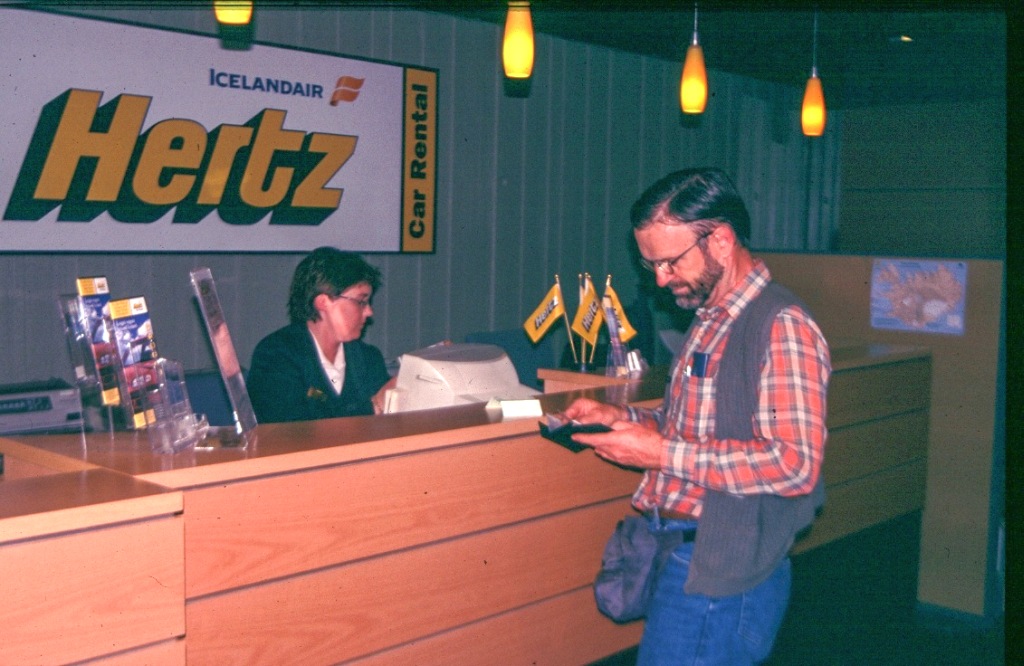 The bus drivers were on strike and there was no bus into town, what's to be done? Either take a taxi at 8000 Krona or hire a car for 5000 plus petrol. After due consideration and some financial evaluation we took the Toyota Corola and drove the 50 km into town on the right hand side of the road. That was actually why we took the additional insurance of 900 Krona. Not that I mistrust Jim's driving, only once did I have to remind him to drive on the right.
The bus drivers were on strike and there was no bus into town, what's to be done? Either take a taxi at 8000 Krona or hire a car for 5000 plus petrol. After due consideration and some financial evaluation we took the Toyota Corola and drove the 50 km into town on the right hand side of the road. That was actually why we took the additional insurance of 900 Krona. Not that I mistrust Jim's driving, only once did I have to remind him to drive on the right.
Everything went all right, we had no accident and by superb navigation made it to the camp-site in Reykjavik. On the way we had one short stop to look at the lava flow that covers this western part of the island. At 23h00 we were still taking pictures, it never gets dark in Iceland this time of the year.
We booked into the camping site at 2100 Krona for two nights for both of us, that makes it about R50 per person per night. Whilst in the reception I bought fuel for my meth cooker at R60 for one litre of denatured ethanol.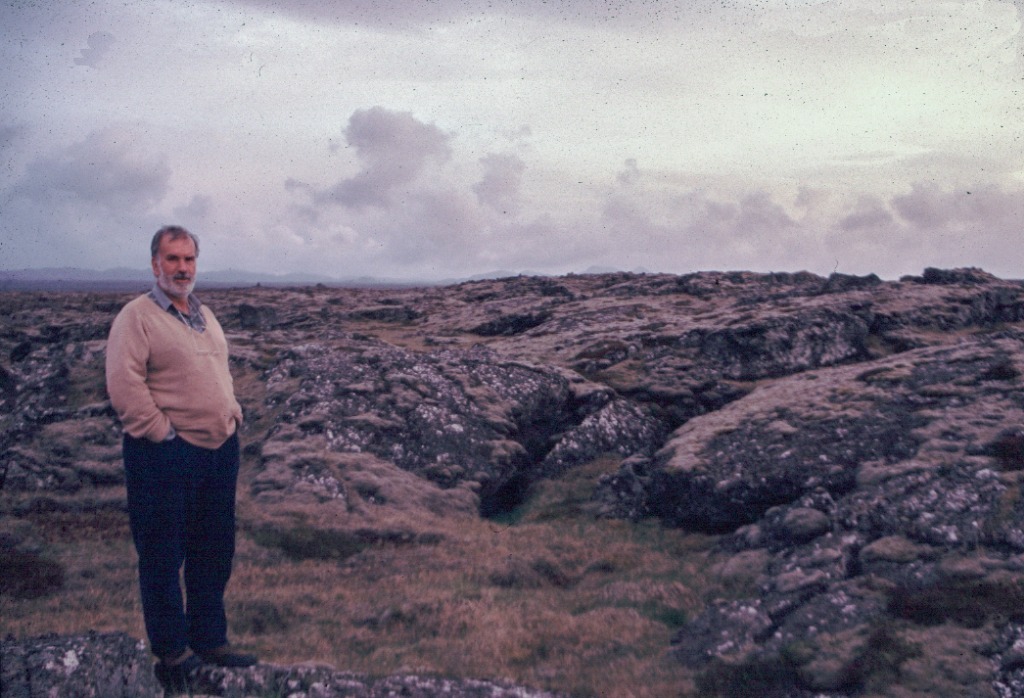
Since we had the car for 24 hours, we thought, it might be the best to use it the next day to do the Golden Circle, that is Þingvellier, Geyser and Gulfoss. For the bus that does that tour we would have paid about R500 each and the car would make us a bit freer.
16. June
9pm lift-off from Jo'burg's nice new Acsa terminal, Horst at the window and old Terry (off to cycle Sussex villages) on the aisle. Comedy radio and films all night for me.
17 June
sat around all day at Heathrow terminal 1 with all their departures computers down, then on our Icelandair plane waiting for manual take-off, reading the Telegraph and the Times, drinking Egil Skallagrimmson 5% beer Horst slept over his Dawkins Rainbow while I got stuck into the Daily Mail. With an east coast bus strike waiting for us at Keflavik, Hertz lent me a wee grey Corolla for a 10pm daylight right-hand side drive to our Reykjavik campsite and a welcome 11 pm sleeping bag.
We slept a bit longer than we wanted to and only got onto the road by ~8h00 without breakfast. That we planned to have on the way somewhere. Going north out of Reykjavik on the N1, that is the national ring road and then taking the regional road to ÞÞingvellir past the lake Þingvallavatn. It was raining most of the way, which precluded us from having this breakfast, but at Þingvellir it cleared a bit and we used the car-park as our breakfast room.
A word about pronunciation; that funny P is not a p but rather a th, therefore the way to say it is Þingvellir. Þingvellir is a very historical place, in geological and in human history. It is on the divide between the North American and the European tectonic plates. Numerous cracks all running in the same direction are visible. The major one is probably the Almannagia, translated the Allrnen gorge. And its place in human history is that it was here that since about 930 the Icelanders had their annual assembly or parliament as we would call it today. Once a year they would come together to discuss, decide and pass judgement in legal cases. It is said to be the oldest parliament of Europe.
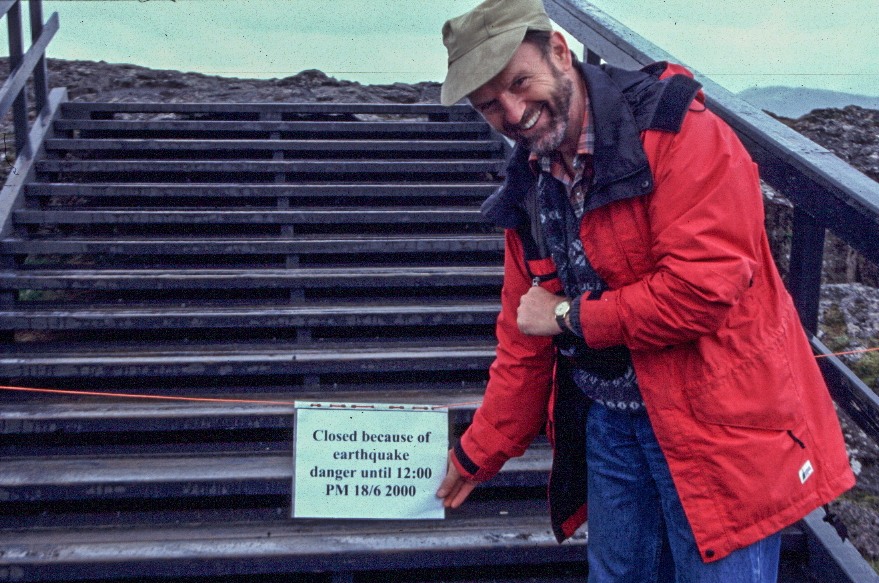 We had good fun there walking from America to Europe and back to America, all along the crack. One place was cordoned off with a notice that this place was closed until l2h00 of that day due to the danger of an earthquake occurring. They had been a tremor the previous day in and around Selfoss. But since it was l1h3O we were not too concerned and made our way through it and down to the hotel.
We had good fun there walking from America to Europe and back to America, all along the crack. One place was cordoned off with a notice that this place was closed until l2h00 of that day due to the danger of an earthquake occurring. They had been a tremor the previous day in and around Selfoss. But since it was l1h3O we were not too concerned and made our way through it and down to the hotel.
All this walking made me feel that I want a cup of coffee, and Jim thought that he could enjoy a beer. This set us back 850 Krona, R60 for the beer and R25 for the coffee. It's possibly the most expensive coffee I ever had and the same can be said for Jim and his beer. The bottle in Quasiarsuk (Greenland), I remember was cheap at R40. But I must say the coffee was very good and the can contained four cups. In the end we didn't pay for the coffee anyway due to some mix up with the waiters.
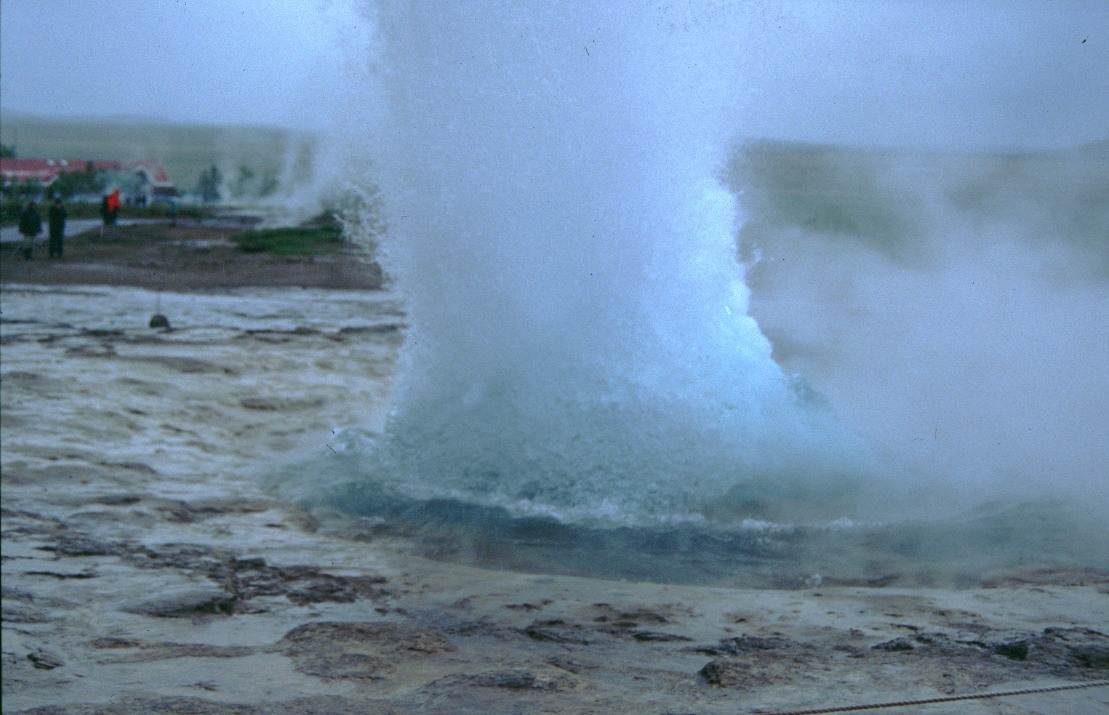 Onward we had to push, it was now l3h00 and we wanted to get to Geyser. This we did, only stopping shortly at a major crack on the other side of the valley. The big Geyser doesn't function nowadays, but a smaller one nearby, Strokkur, comes up every 5 to l0 minutes. Apart from this geyser there are a number of hot springs.
Onward we had to push, it was now l3h00 and we wanted to get to Geyser. This we did, only stopping shortly at a major crack on the other side of the valley. The big Geyser doesn't function nowadays, but a smaller one nearby, Strokkur, comes up every 5 to l0 minutes. Apart from this geyser there are a number of hot springs.
It is now 22h45, the sun is still shining and I am sitting on one of the tables at the camp-site.
The sun only disappeared at about 23h30. But one should not take this to mean that it will be back up by 0h30. Iceland is using Greenwich meantime. That means that the true midnight is closer to 01h30 (23° W longitude). But a fact is that it never really gets dark at this time of the year. I was able to see my watch and check the time at 2h30 without using my torch.
18 June
 drizzly drive past patches of snow to Þingvallavatn (lake) for coffee and Old Amsterdam on Provita in the car park Explored Þingvellir rift and Iceland is 930-1262 (Golden Age) Althingi parliament area. Enjoyed a (last) R60 pint of Egils Gull (ol) as Horst had R25 coffee below rude paintings in the hotel bar Drove on to Geysir - which should be renamed Strokkur for its active geysir - then the gold falls of Gullfoss, then south by Grimsnes 5000-year old volcanic caldera Kerid to Selfoss and back via the greenhouses of Hveragerdi to return the car and walk back to camp. A costly, scenic day.
drizzly drive past patches of snow to Þingvallavatn (lake) for coffee and Old Amsterdam on Provita in the car park Explored Þingvellir rift and Iceland is 930-1262 (Golden Age) Althingi parliament area. Enjoyed a (last) R60 pint of Egils Gull (ol) as Horst had R25 coffee below rude paintings in the hotel bar Drove on to Geysir - which should be renamed Strokkur for its active geysir - then the gold falls of Gullfoss, then south by Grimsnes 5000-year old volcanic caldera Kerid to Selfoss and back via the greenhouses of Hveragerdi to return the car and walk back to camp. A costly, scenic day.
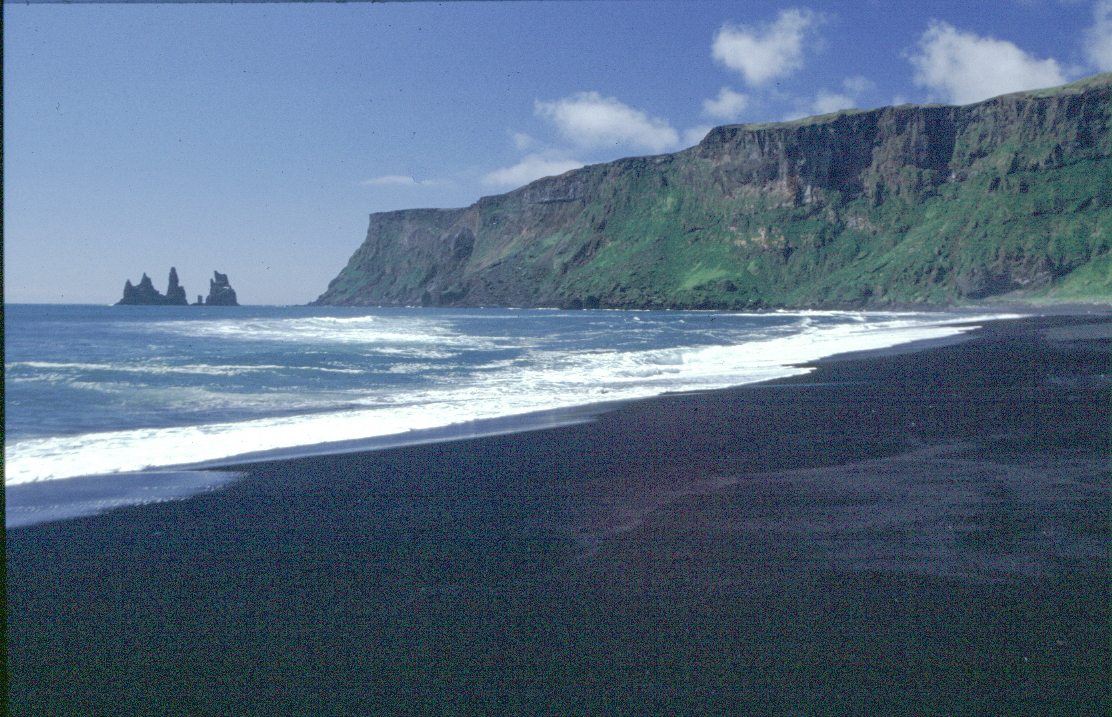 Instead of walking to the bus station, 45-minute Walk, we rather used the city bus at a cost of 150 Krona. We used the point to get off and still had to walk some distance to the bus station. The aim today was to get to Skaftafell, a journey of 340 km. The fare was just short of 4000 Krona and departure time 08h30. So we did, on time. Taking the route all along the national road no.1 through Selfoss, Hella, Vik and Kirkjubzejarklaustur, just to mention the larger places. At Vlk the bus stopped for about 25 minutes, which gave me a chance to stroll down to the beach.
Instead of walking to the bus station, 45-minute Walk, we rather used the city bus at a cost of 150 Krona. We used the point to get off and still had to walk some distance to the bus station. The aim today was to get to Skaftafell, a journey of 340 km. The fare was just short of 4000 Krona and departure time 08h30. So we did, on time. Taking the route all along the national road no.1 through Selfoss, Hella, Vik and Kirkjubzejarklaustur, just to mention the larger places. At Vlk the bus stopped for about 25 minutes, which gave me a chance to stroll down to the beach.
Lovely scenery awaited me with breaking white waves, a black beach, and lots of birds. We did feel a bit peckish towards lunchtime but refused to buy any of the R65 hamburgers on offer. The coke I bought at the bus station set me back R16.
The bus got us to Skaftafell by about l4h00. The last couple of kilometres was through a stone and water desert. This is the major run-off' from the Vatnajokull forming a huge floodplain. The Icelanders are having a hard time maintaining this piece of road since it is
susceptible to flooding which tends to take out bridges and pieces of road.
We paid 2000 Krona for two nights and set up camp on the rather large camping area. They must be expecting a lot of visitors during the main season starting on the 1-July.
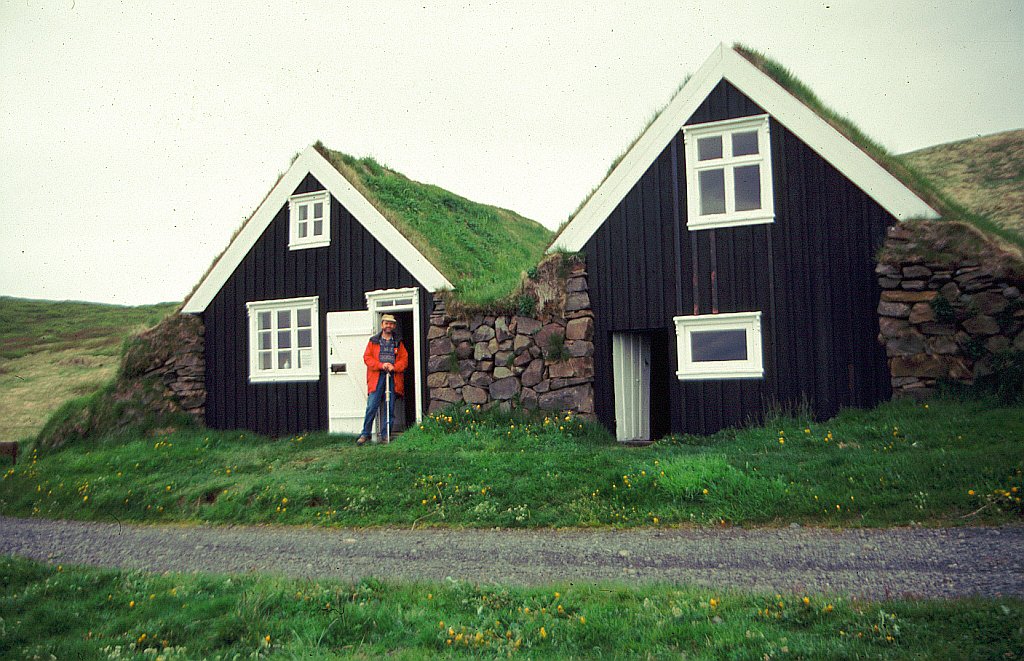 The first thing to do was to visit the nearby glacier, Skaftafelljokull. It melts off about a kilometre away from the camp and is easy to walk onto, which; of course, we did for a fair distance. Also having a look at the side where it scrapes the mountain. The power of
these glaciers is so impressive.
The first thing to do was to visit the nearby glacier, Skaftafelljokull. It melts off about a kilometre away from the camp and is easy to walk onto, which; of course, we did for a fair distance. Also having a look at the side where it scrapes the mountain. The power of
these glaciers is so impressive. 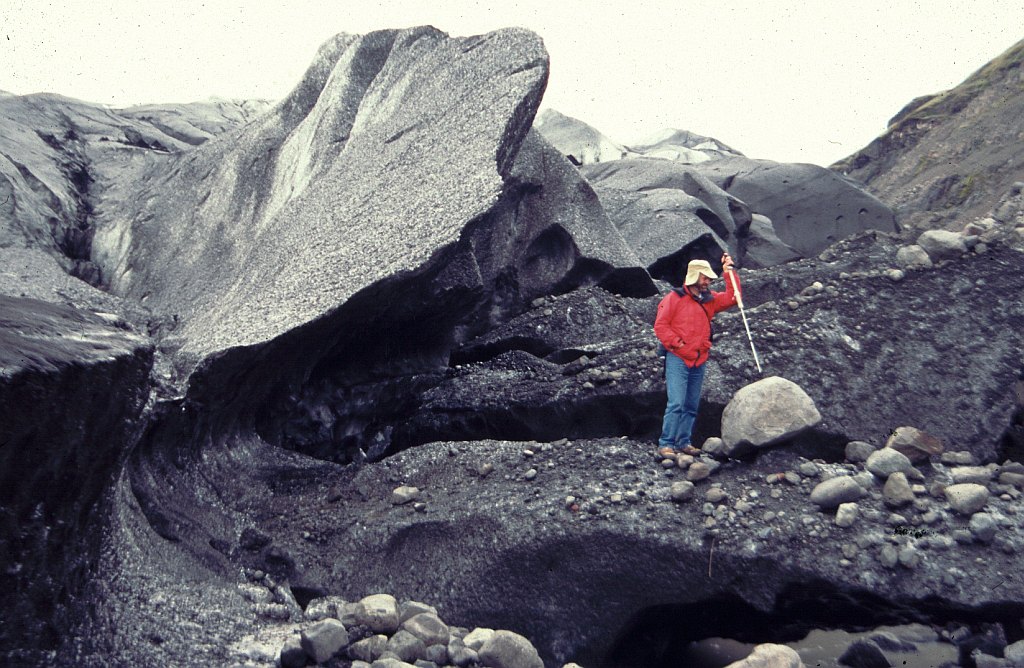
The day was still young as we returned from the glacier, only 17hOO. Had some coffee and marched off again to take a look at some waterfalls close by. Passing a farm we noticed a restored old farmhouse. It was restored by the farmer, anybody is welcome to look inside it, all the farmer wants is that we sign the visitor's book. It was one of those typical houses with the grass on the roof; this particular one was occupied until the beginning of last century (early 1900). Interesting was the layout, the bedroom is above the stable so that the heat from the animals would warm up the top floor.
19 June
porridge and coffee, city bus and walk to the bus station for our bus along the south coast to Skaftafell. The severe city and rural architecture uses (like Greenland) a few bold colours, and there ’s lots of abstract stone, concrete and metal sculpture, like those seafront poles with stylised plastic scenes and taped conversations. Reykjavik is dominated by four huge silver pillboxes (hot water reservoirs) topped by a dome (revolving restaurant) on a knoll above the airport. Gardens, graveyards and parks are lush with tulips, grape hyacinths, buttercups, dandelions, lush grass, birches and rowans, and school kids plant out masses of seedlings in highway centre-beds.
The rural lowlands are all ice-swollen tussocks and sphagnum moss, except where 2m-deep drainage ditches act as fences for sheep/horse pastures. A decorative teen blond who hopes for a massage career chatted on the bus. The sun shone on Vik's black-pebble beach, oyster catchers, curlews and terns. (Vik = coast; Viking = raiding along the coast) Waterfalls, basalt towers, distant Hekla, and an endless lava plain (from a 25km-long 17th century eruption, says H).
Skaftavell camp-site, up-tent and lunch, then off on foot to Skaftafellsjokull and up its dirty lip. After supper in the tent, we walked up to Sel's reconstructed stone, wood and turf farmhouse with basement central-cow heating and fluffy Icelandic ponies nearby, then down by a pretty birch pool for an early night.
continue
return to home page